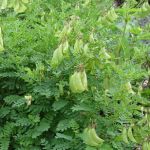| Common Name: |
Membranaceous Milk Vetch |
| Other Names: |
Tragacanth, Beg Kei, Huang Qi, Gum tragacanth |
| Botanical Name: |
Astralagus gummifer |
| Genus: |
Astralagus |
| Family: |
Papilionaceae |
| Native Location: |
Middle East (Kurdistan) |
| Cultivation: |
Well-drained soil in sun. Astralagus membranaceus prefers sandy, slightly alkaline soil. |
| Propagation: |
By seed in spring or autumn |
| Harvest: |
Gum is collected from second-year plants of A. gummifer by incising the stem base; it is dried for use as a powder. Roots of A. membranaceus are lifted in autumn and dried for decoctions, powders, and tinctures. |
| Height: |
30cm (12in) |
| Width: |
30cm (12in) |
| Hardiness: |
Z8-10 |
| Parts Used: |
Gum, Root |
| Properties: |
A mucilaginous herb that stimulates the immune system and suppresses tumors. |
| Medicinal Uses: |
To treat depression of the immune system, heart failure, viral infections, respiratory infections, liver disease, and kidney disease. |
| Typical Dose: |
A typical daily dose of astralagus may range from 2 to 6gm of dried root or 4 to 12ml of fluid extract. |
| Possible Side Effects: |
Astralagus's more common side effects, as suggested by animal studies, include respiratory depression and allergic reactions. |
| Drug Interactions: |
| Taking astralagus with these drugs may increase the risk of bleeding or bruising: |
| Abciximab (ReoPro) |
Alteplase (Activase, Cathflo Activase) |
Antithrombin III (Thrombate III) |
Argatropan |
| Aspirin (Bufferin, Ecotrin) |
Aspirin and Dipyridamole (Aggrenox) |
Bivalirudin (Angiomax) |
Clopidogrel (Plavix) |
| Dateparin (Fragmin) |
Danaparoid (Orgaran) |
Dipyridimole (Novo-Dipiradol, Persantine) |
Enoxaparin (Lovenox) |
| Eptifibatide (Integrillin) |
Fondaparinux (Arixtra) |
Heparin (Hepalean, Hep-Lock) |
Indobufen (Ibustrin) |
| Lepirudin (Refludan) |
Nadroparin (Fraxiparine) |
Reteplase (Retavase) |
Streptokinase (Streptase) |
| Tenecteplase (TNKase) |
Ticlopidine (Alti-Ticlopidine, Ticlid) |
Tinzaparin (Innohep) |
Tirofiban (Aggrastat) |
| Urokinase (Abbokinase) |
Warfarin (Coumadin, Jantoven) |
| Taking Astralagus with these drugs may reduce the drug's immunosuppressive effects: |
| Antithymocyte Globulin, Equine (Atgam) |
Antithymocyte Globulin, Rabbit (Thymoglobulin) |
Azathioprine (Imuran) |
Basiliximab (Simulect) |
| Beclomethasone (Beconase, Vanceril) |
Betamethasone (Betatrex, Maxivate) |
Budesonide (Entocort, Rhinocort) |
Budesonide and Formoterol (Symbicort) |
| Cortisone (Cortone) |
Cyclophosphamide (Cytoxan, Neosar) |
Cyclosporine (Neoral, Sandimmune) |
Daclizumab (Zenapax) |
| Deflazacort (Calcort, Dezacor) |
Dexamethasone (Decadron, Dexasone) |
Efalizumab (Raptiva) |
Flunisolide (AeroBid, Nasarel) |
| Fluoromethalone (Eflone, Flarex) |
Fluticason (Cutivate, Flonase) |
Hydrocortisone (Cetacort, Locoid) |
Loteprednol (Alrex, Lotemax) |
| Medrysone (HMS Liquifilm) |
Methotrexate (Rheumatrex, Trexall) |
Methylprednisolone (Depo-Medrol, Medrol) |
Muromonab-CD3 (Orthoclone OKT3) |
| Mycophenolate (CellCept) |
Pimecrolimus (Elidel) |
Prednisolone (Inflamase Forte, Pred Forte) |
Prednisone (Apo-Prednisone, Deltasone) |
| Rimexolone (Vexol) |
Spirolimus (Rapamune) |
Tacrolimus (Prograf, Protopic) |
Thalidomide (Thalomid) |
| Triamcinolone (Aristocort, Trinasal) |
| Taking astralagus with this drug may increase the drug's tumor cell-killing ability and decrease the drug's side effects: |
| Aldesleukin (Proleukin) |
|
| Lab Test Alterations: |
May increase sperm mobility in vitro and alter results of semen specimen analysis. |
| Disease Interactions: |
- May worsen autoimmune diseases by increasing the activity of the immune system.
- May interfere with the body's ability to accept transplanted tissues by hampering immunosuppressive medicines.
|
| Economic Uses: |
Used as a stabalizing and thickening agent in the food and pharmaceutical industries, in products such as salad dressings, ice creams, desserts, sauces, processed cheese, candy and toothpaste. |
| Bibliography: |
Encyclopedia of Herbs by Deni Brown Copyright © 1995, 2001 Dorling Kindersley Limited Pp 136-137
The Essential Herb-Drug-Vitamin Interaction Guide by George T. Grossberg, M.D., and Barry Fox, Ph.D. Copyright © 2007 by Barry Fox, Ph.D. pp. 53-55 |

